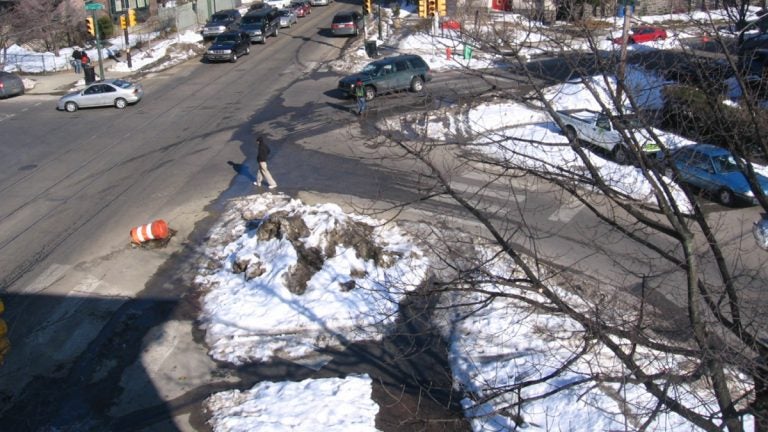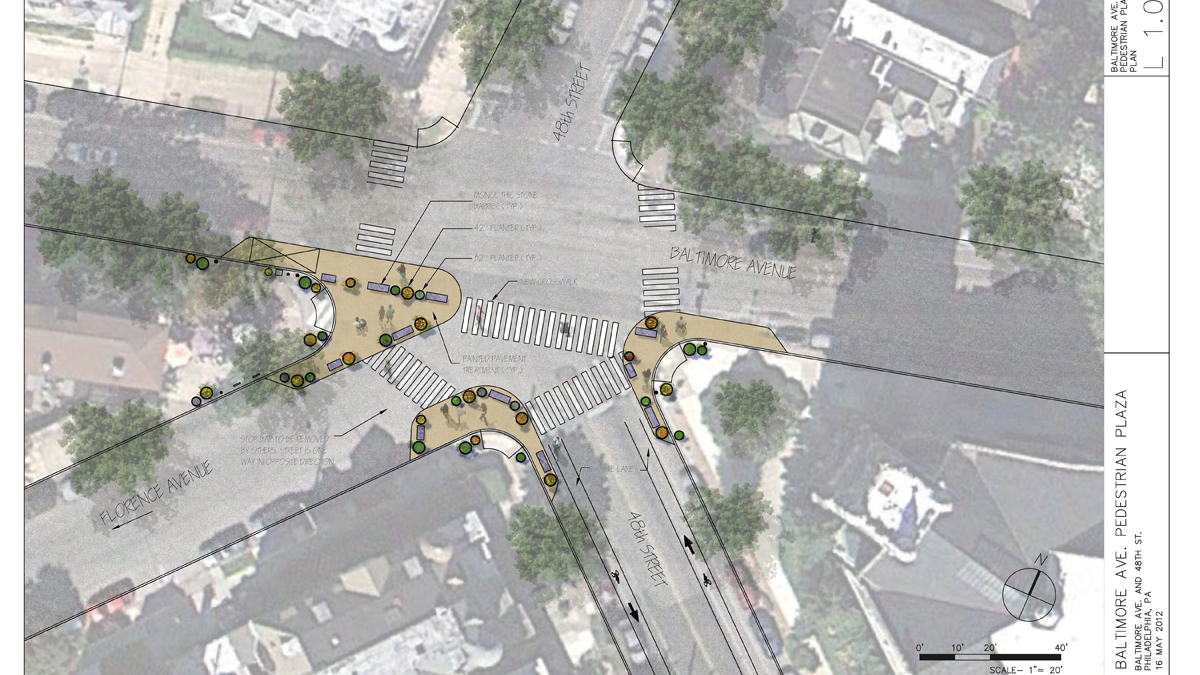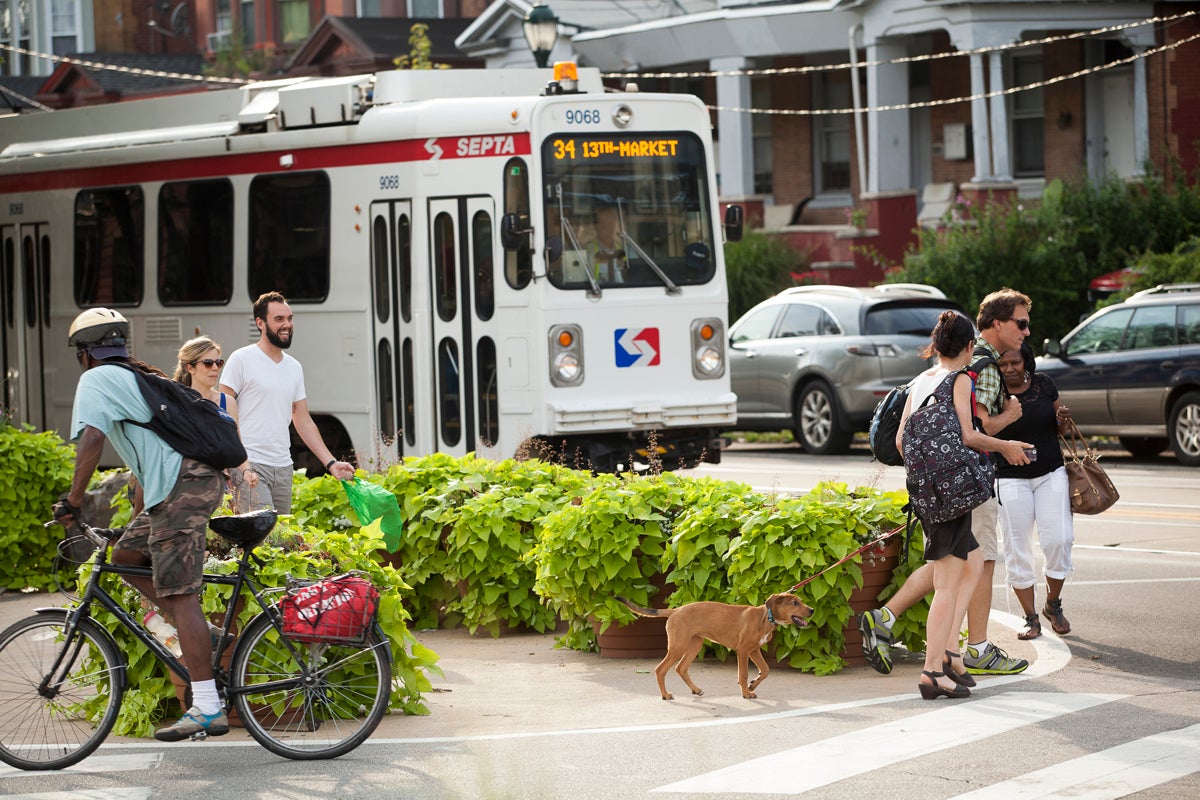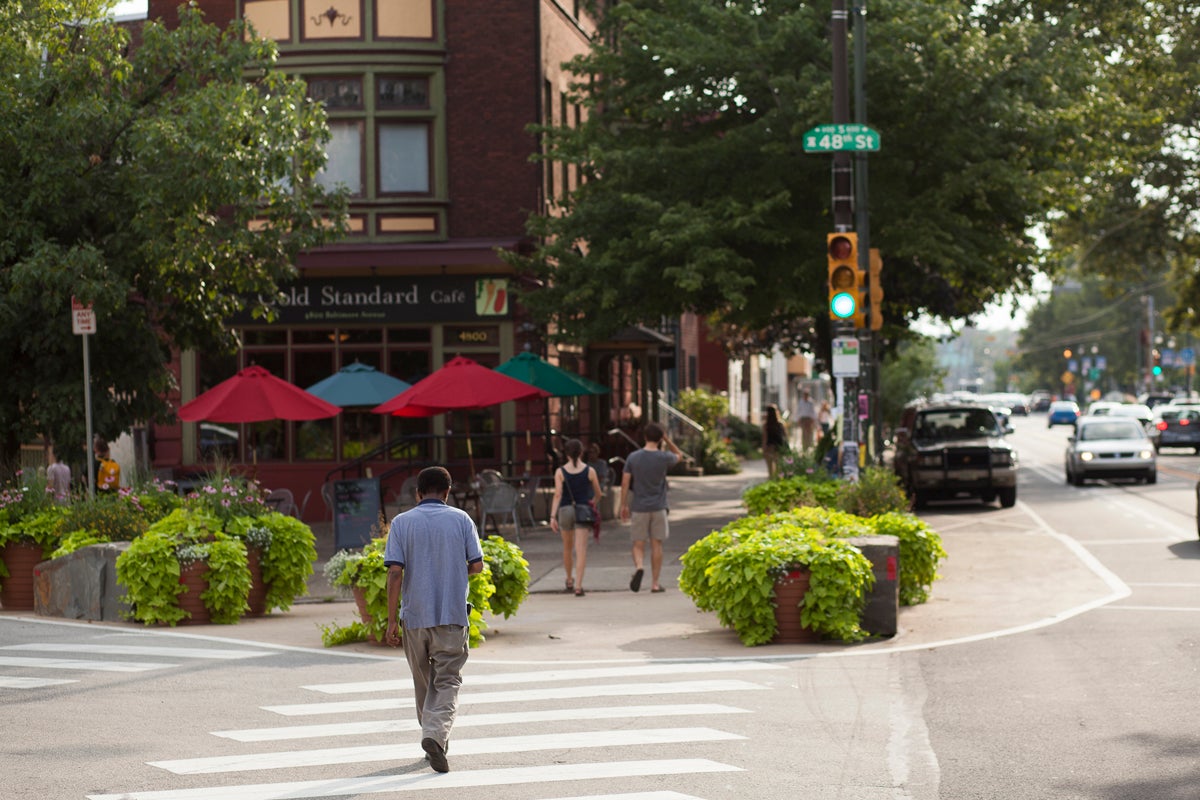Re-envisioning street corners, thanks to snow piles

Snow piles at the corner of 48th Street and Baltimore Avenue in Philadelphia. (University City District)
Some say the piles of ice and snow in the street that remain after plowing — often several feet from the curb — are an opportunity to re-envision cities.
Ah, fresh snowfall. It’s magical, isn’t it? The whole world is covered in white powder, drivers have to slow down (or stop driving entirely) and life stands still for a brief moment.
If you live in a city, that moment is especially brief. Before you know it, the snow is packed down with footprints and tire tracks, and it turns gray and even black from the traffic.
There are some people who think this unfortunate encroachment of civilization on nature can actually be an opportunity for urbanists. They say the piles of ice and snow that remain in the street after plowing — often several feet from the curb — are an opportunity to re-envision city street corners.
Many urban planners say people have ceded too much space to cars and that cities should take some of that space back for pedestrians and cyclists. This idea is part of a planning approach called smart growth, an attempt to make cities more walkable and bikeable, and to combat sprawl.
One smart growth tactic is called a curb extension, or “neckdown.” Planners say extending curbs has a few benefits: it can make people drive more slowly around corners, improve visibility for drivers and make crossing the street faster for pedestrians. These extensions can also include public benches and planters — more space for the people on foot, less for the ones in cars.
Enter snow piles. The thinking goes that if drivers can navigate the temporary piles of snow and ice that accumulate after plowing, they could also get around a curb extension or pedestrian plaza in that same spot. To put it poetically, as an advocate named Clarence Eckerson Jr. told the BBC in 2014, “the snow is almost like nature’s tracing paper.”
Eckerson, who lives in Carroll Gardens, Brooklyn, produces short films about transportation policy and urban design for a firm called Streetfilms. Back in 2006, he filmed his neighborhood after a big snowstorm to show that these snow piles could be planning tools.
Eckerson was inspired by an earlier article in the magazine Transportation Alternatives, which talked about how snow can calm traffic. (On his blog, he writes that urban planners have been studying snow patterns since at least the mid-1990s.) Eckerson later came up with a name for these snow piles: “snowy neckdowns,” which a Twitter user shortened to “sneckdowns.”
Sneckdowns are meant as crude inspiration, not as an exact marker for where curb extensions should go.
But they have gone beyond the aspirational. In Philadelphia, University City District, a nonprofit that aims to improve the quality of life in the 2.4 square mile neighborhood, used sneckdowns to envision a pedestrian plaza on the corner of 48th Street and Baltimore Avenue.

Rendering of 48th Street and Baltimore Avenue pedestrian plaza. The brown areas are parts of the plaza, inspired by sneckdowns. (University City District)
The district held community meetings and worked with the Philadelphia Streets Department to get the permits it needed, says Nate Hommel, director of planning and design for the group. Then it hired a landscape architecture firm to design planters and stone blocks to shield pedestrians from traffic. The city painted the curb and added a crosswalk.

The pedestrian plaza at 48th Street and Baltimore Avenue. (University City District)

A different view of the pedestrian plaza at 48th Street and Baltimore Avenue in Philadelphia. (University City District)
Last year, PlanPhilly‘s Jon Geeting highlighted other Philadelphia sneckdowns, which could become curb extensions, for This Old City. The post garnered mentions in The Guardian and Fast Company’s Co.Exist, as well as more than 200 comments, many of them positive, and not just from people in Philadelphia. Commenters lived in cities in Colorado, Texas, Mexico and beyond.
On Geeting’s blog, some commenters raised concerns that these extensions could limit the ability of large trucks and emergency vehicles to navigate the streets as well as reduce the number of parking spots.
Those problems don’t have to sink a project, though. In University City, the Streets Department did a turn analysis to make sure large vehicles could still safely make turns once the pedestrian plaza was installed, Hommel says. The plaza didn’t remove any legal parking spaces.
Other commenters on Geeting’s blog wondered whether the extensions would take away room from cyclists. There are ways to avoid that, like designing a curb extension so a bike lane passes through it.
Keep in mind that curb extensions don’t have to be expensive — or even permanent. When installing an extension on one street corner, the city of Austin recently decided to forego concrete. Instead, workers spray painted blue and green polka dots on the ground and marked the extension with short plastic poles. If the installation causes problems, the city can easily remove it or redesign it.
WHYY is your source for fact-based, in-depth journalism and information. As a nonprofit organization, we rely on financial support from readers like you. Please give today.


